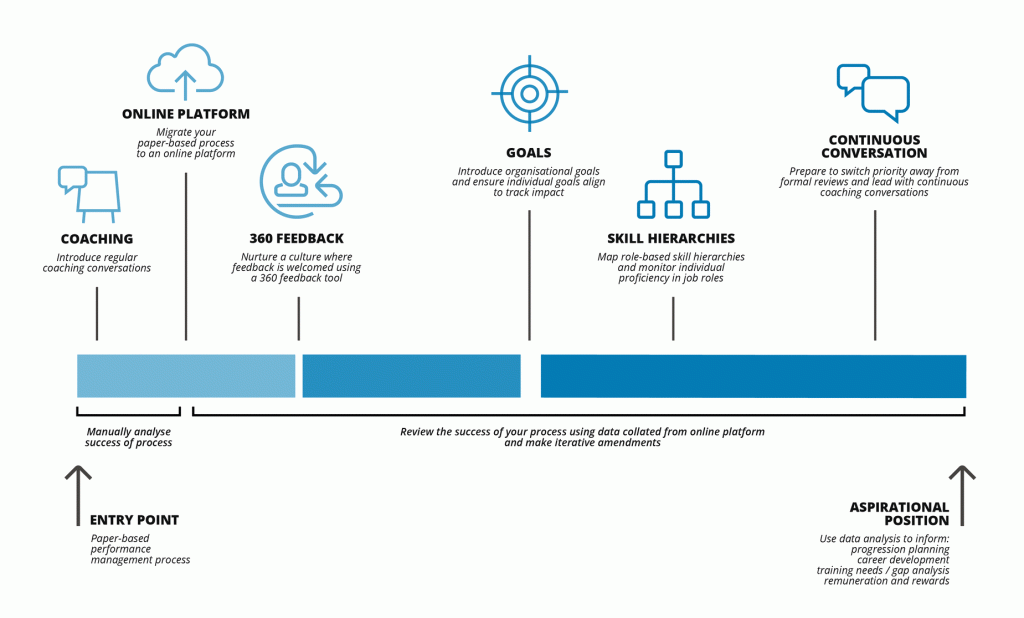You’ve introduced a coaching culture and selected an online platform to simplify and automate the continuous performance management process.
The next step in the performance management continuum is to add 360-degree feedback to your process.
According to the Chartered Institute of Personnel and Development, 360 degree or multisource feedback means between 8-10 colleagues complete questionnaires on an employee’s performance.
Reviewers can include peers, direct reports, more senior colleagues or customers.
Did you know that a staggering 96% of employees want to receive regular feedback?
The reasons for gathering 360-degree feedback are that managers find it difficult to fully understand the contribution of the people they manage, and managers are often looking at different skills than peers.
So obtaining information from more sources, internal and external, helps the employees and managers form a more accurate picture of performance and helps mitigate bias.

Enabling continuous 360 feedback is a powerful feature in Totara Perform that automates the gathering and sharing of feedback in multiple ways as well as inviting feedback on individual performance.
Akin to the societal expectation of instant access to information, there is an expectation in today’s workplace of continuous performance feedback.
Put simply, employees want to know on an ongoing basis “How am I doing?”
A digital system to manage and monitor conversations related to an employees’ day-to-day workflow means organizations can answer the above question promptly and precisely.
Feedback gradually shifts from a single, formal and scheduled event, to “business as usual.”
Which employee feedback methodology is best?
2 simple but effective feedback models are the SBI (Situation Behavior Impact) and SSC (Stop Start Continue) models explained below.
The Situation-Behavior-Impact™ Feedback Tool (SBI™) stands for:
-
Situation: You outline the situation you’re referring to so that the context is clear and specific
-
Behavior: You discuss the precise behavior that you want to address
-
Impact: Finally, you highlight the impact of the person’s behavior on you, the team and the organization
I don’t have an official definition for the SSC model, nor can I trace where it originated, but I first learned about it in Mark Effron’s book “ One Page Talent Management .”
Stop: What should the employee stop doing?
This part looks backward and allows the manager to outline behaviors or actions that did not contribute to success for the employee or company.
Start: What should the employee begin doing or do more?
This part allows the manager to look ahead and identify activities that the employee will do or should start doing in the coming future.
It can also identify behaviors that should be nurtured to help the employee succeed.
Continue: What should the employee keep doing?
At this stage, you’ll discuss behaviors or actions that worked and that contributed to the employee’s success, goal achievement or progress.
These elements should be continued and developed to leverage the employees’ success. It is also an opportunity to acknowledge success and reinforce behavior.
With a performance management system like Totara Perform, you can also choose whether the feedback is anonymous or not. There are pros and cons to both options.
Anonymous Feedback Pros
-
Peers and direct reports provide honest feedback – A skill of being a good manager is being able to provide constructive feedback, but colleagues may feel uncomfortable giving feedback to someone they work with or even their manager
-
Keeps the focus on the feedback – If we’re honest, dynamics in teams are part of everyday working life and can contribute to bias. Keeping feedback anonymous forces the recipient to focus on the content of the feedback, rather than one person’s thoughts i.e. “he never liked me anyway”
-
Maintains healthy working relationships in your organization – Not everybody treats feedback as a gift and even well-intentioned feedback could cause workplace unrest
Anonymous Feedback Cons
-
People can be rude knowing their identity is protected – You only have to look at the abuse that people get online. Unfortunately, it’s human nature. People are much more likely to be unkind when they can hide behind the cover of anonymity.
-
People can pursue ulterior motives – Earlier we said that anonymous feedback allows the recipient to focus on the feedback rather than who gave it to them. Sometimes this feedback can be accurate, however, it could also be more personal or vindictive in nature
-
Goes against a transparent culture – organizations try to have an open, honest culture. Anonymous feedback goes against this
According to the Chartered Institute of Personnel and Development (CIPD), there is also growing research that strength-based conversations can work better to help employees build their strengths and replicate successes in other areas of their work.
Strength-based approaches tend to take a coaching style and be more future-focused, which may be part of the reason for their effectiveness.
This doesn’t mean ignoring underperformance, but rather taking a default approach of focusing on what’s already working well.
Whichever method you choose, for it to be effective, employees must feel confident that 360-degree feedback is trustworthy and fair.
In the next post, you’ll learn how to introduce goals to your burgeoning performance management process.






